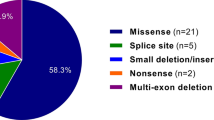Abstract
Background
Hereditary ichthyosis is a clinically and genetically heterogeneous disorder associated with more than 50 genes with TGM1, ALOX12B, and ALOXE3 being the most prevalent. Establishing an accurate diagnosis is important for effective genetic counseling and optimal patient management.
Objective
We studied the diagnostic value of whole exome sequencing (WES) in a small case series with hereditary ichthyosis.
Methods
During a 1-year period, index cases of 5 unrelated families clinically diagnosed with hereditary ichthyosis went through WES, followed by extensive segregation analysis. Prenatal diagnosis (PND) was conducted where indicated.
Results
We identified 4 homozygous variants-2 in TGM1 (c.655A > G and c.797A > G) and 2 in ALOX12B (c.527 + 2 T > G and c.1654G > T)-alongside a heterozygous variant in TGM1 (c.428G > A) in 5 families. The variants were all pathogenic/likely pathogenic according to the ACMG classification and segregation analysis, except for c.797A > G in TGM1 which remained a variant of unknown clinical significance. Four variants were novel. All families were referred either during pregnancy or before reproductive planning; 4 benefited from WES as it identified the mutation in the probands and enabled carrier detection in at-risk relatives; PND was conducted in 2 families.
Conclusion
Our findings further support WES is a powerful tool for the comprehensive, accurate, and rapid molecular diagnosis of hereditary ichthyosis and can offer opportunities for reproductive planning, carrier screening and prenatal diagnosis to at-risk families.

Similar content being viewed by others
References
Chiu FP-C, Doolan BJ, McGrath JA, Onoufriadis A (2021) A decade of next-generation sequencing in genodermatoses: the impact on gene discovery and clinical diagnostics. Br J Dermatol 184(4):606–616. https://doi.org/10.1111/bjd.19384
Joosten MDW, Clabbers JMK, Jonca N, Mazereeuw-Hautier J, Gostyński AH (2022) New developments in the molecular treatment of ichthyosis: review of the literature. Orphanet J Rare Dis 17(1):269. https://doi.org/10.1186/s13023-022-02430-6
Saadat M, Zarghami M (2017) Consanguineous marriages among Iranian Mandaeans living in South-West Iran. J Biosoc Sci 50(4):451–456. https://doi.org/10.1017/S0021932017000207
Sitek JC, Kulseth MA, Rypdal KB, Skodje T, Sheng Y, Retterstøl L (2018) Whole-exome sequencing for diagnosis of hereditary ichthyosis. J Eur Acad Dermatol Venereol 32(6):1022–1027. https://doi.org/10.1111/jdv.14870
Vahlquist A, Fischer J, Törmä H (2018) Inherited nonsyndromic ichthyoses: an update on pathophysiology, diagnosis and treatment. Am J Clin Dermatol 19(1):51–66. https://doi.org/10.1007/s40257-017-0313-x
Author information
Authors and Affiliations
Contributions
MCH, MM, and MR analyzed the data, made the figures and tables, and wrote the manuscript. ME, MR and SRG supervised the project. AH, SR, HA, FK, and NM managed the DNA sequencing and bioinformatics. OM, ET, and FH performed genetic counseling and clinical analysis. All authors reviewed and edited the manuscript.
Corresponding authors
Ethics declarations
Competing interests
The authors declare no competing interests.
Additional information
Publisher's Note
Springer Nature remains neutral with regard to jurisdictional claims in published maps and institutional affiliations.
Rights and permissions
Springer Nature or its licensor (e.g. a society or other partner) holds exclusive rights to this article under a publishing agreement with the author(s) or other rightsholder(s); author self-archiving of the accepted manuscript version of this article is solely governed by the terms of such publishing agreement and applicable law.
About this article
Cite this article
Chegini, M., Eslami, M., Motavaf, M. et al. Whole exome sequencing identifies novel pathogenic variants in TGM1 and ALOX12B in patients with hereditary ichthyosis. Arch Dermatol Res 316, 24 (2024). https://doi.org/10.1007/s00403-023-02775-3
Received:
Revised:
Accepted:
Published:
DOI: https://doi.org/10.1007/s00403-023-02775-3




